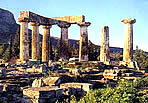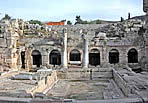Corinth Acts 18:1; 19:1; 1 Corinthians 1:2; 2 Corinthians 1:1, 23; 2 Timothy 4:20
Because St. Paul spent more than one and one half years at
Corinth during his Second Journey, the city remains important to
students of the Book of Acts. This city was constructed in antiquity
on a narrow isthmus, a cosmopolitan city that connected the
Peloponnese and the Balkan
 Peninsula.
Corinth had deep-water harbors on each side, with Cenchrea on the
east end, and Lechaeum on the west. Thus the city's natural location
made it a very wealthy commercial and shipping center.
Peninsula.
Corinth had deep-water harbors on each side, with Cenchrea on the
east end, and Lechaeum on the west. Thus the city's natural location
made it a very wealthy commercial and shipping center.
The city also enjoyed a long and important history among Greek
city-states from the Neolithic through Archaic Periods. Scholars
agree that a Neolithic settlement was located near the Peirene
Spring from about 4,000 BCE. That settlement eventually disappeared,
but eight distinct settlements are known from the plain near Corinth
by 2,000 BCE. By 1800 BCE, influence and invasion affected the
development. Following the Dark Age of Greece (1100-800 BCE) with
its characteristic invasion waves, the expansion of the Dorian
people group was illustrated by their colonization of Syracuse and
Corcyra from areas like Corinth.
Some scholars claim the archaic foundations of the organized city
appear to date to the 8th century BCE. In the two centuries that
followed, before the Classical Period, the city appropriated a
number of myths that actually originated elsewhere. It adopted the
Pegasus (winged horse) and the mythology of its capture by
Bellerophon, a story that belonged originally to Asia Minor, and
made it the symbol of Corinth.
By the Classical Period, Corinth was one of the powerhouse
city-states, ranking with Sparta and Athens in value, though not as
militarily strong. Corinth was essential to the routing of the
Persians during the period, and played special roles in a number of
campaigns. During the Peloponnesian Wars (the period of tensions
between Athens and Sparta, 431-404 BCE), Corinth often found itself
in a difficult position between the two cities. In general, the
strategic position and economy aided the city in becoming a key
player in many alliances. It was important to Philip II (who
garrisoned the mount of Acrocorinth) and later even became the capital of the
Aechean League for a short time before it aligned against the rising
Roman power.
the mount of Acrocorinth) and later even became the capital of the
Aechean League for a short time before it aligned against the rising
Roman power.
Because of its stance against the expansion of Roman power, the
Roman General Mummius laid the city waste in 146 BCE. By 46 BCE,
Julius Caesar re-colonized the area and gave it the status of Roman
capital of Achaia. From that time Corinth enjoyed much freedom as an
independent city.
The city had a large theater and was frequented by the Emperors of
Rome for the Isthmian games. Several scholars note the population
may have exceeded 400,000 for some of the Roman period. Another
important attraction to the Roman city was in the Acrocorinth. This
hill, about 1886 feet above the plain, formed a natural and
impregnable defense for ancient Corinth. By the time of the Romans
such defenses were not so important, but the establishment of the
great temple of Aphrodite and its numerous temple prostitutes (the
number in some sources is reported at more than 1000!) made the
place notable to ancient historians.
The city agora or market place boasted nightclubs or bars (33
taverns have been excavated). The city was known for luxury,
pleasure and especially immorality - a key to concern of St. Paul in
his first letter to Corinthians. The city was a mixture population
(Greeks, Romans, Jews, Italians, etc.) and attracted thousands by
its reputation for "base" entertainment. Important trade links were
maintained with Italy and Asia Minor via Ephesus.
St. Paul's initial visit to Corinth was on his Second Journey, when
he arrived from Athens about 50-51 CE. He spent one year and six
months there while working as a tentmaker and lodged with Aquila and
Priscilla who moved to Corinth after the expulsion of Jews from Rome
by Emperor Claudius (49 or 50 CE). St. Paul told Timothy and Silas
to remain behind to strengthen
 churches
when St. Paul was forced to leave Berea and they rejoined St. Paul
in Corinth from Macedonia.
churches
when St. Paul was forced to leave Berea and they rejoined St. Paul
in Corinth from Macedonia.
When they arrived, St. Paul was busy with forming the new
congregation of followers as he " reasoned in the synagogue every
Sabbath, and persuaded the Jews and the Greeks." He began preaching
in the Jewish community and when the leadership opposed him he
departed from the synagogue and taught the disciples in the house of
Justus located next to the synagogue. Among those who believed was
the chief synagogue ruler, Crispus.
St. Paul was assured by a vision that Jesus would protect him if he
remained in Corinth at the ministry task. Shortly after the vision
the message was tested. He was brought to the judgment (bema) seat
before Gallio (the newly appointed deputy of Achaia) by some local
Jewish leaders who accused him of persuading people to worship God
contrary to the law (Acts 18: 12-16).
Gallio chose not to involve himself in the matter and drove them
away. This judgment seat that St. Paul was brought before has been
uncovered in the center of the market place or agora. There were two
lower steps that surrounded a high platform (five feet or so),
covered with marble. The platform was more than thirty feet long,
and had been restored by archaeologists.
The friends St. Paul met at Corinth (Aquila and Priscilla) became
true partners in ministry. No doubt their encouragement helped to
revive the Apostle after the terrible experiences associated with
his second journey as he came into Macedonia and Achaia. In addition
to their encouragement, we have record of their continued ministry
after they departed Corinth and went to Ephesus. A Messianic teacher
named Apollos taught about Jesus to the local believers, but taught
about the baptism of John. Aquila and Priscilla knew from listening
to St. Paul the message had progressed further and took Apollos
aside and explained to him the more complete information.
Perhaps during those conversations Apollos gained the desire to move
on to Corinth, for he continued the work that St. Paul had started
there and was mightily used to further the ministry. (see Acts
18:23,24,26-28;19:1) St. Paul's Epistle to the Romans was written in
Corinth. (Romans 16:23) St. Paul was evidently staying with a man
named Gaius, St. Paul's host, and aided by the amanuensis Tertius
who was scribed the letter. The first and second epistles to the
 Thessalonians
were also written from Corinth (I Thessalonians 3: 6-7). Timothy
returned from Thessalonica with reports on how the ministry
progressed after St. Paul's forced departure.
Thessalonians
were also written from Corinth (I Thessalonians 3: 6-7). Timothy
returned from Thessalonica with reports on how the ministry
progressed after St. Paul's forced departure.
St. Paul wrote the first Epistle to the Corinthians from Ephesus
some time later. Timothy may have been the bearer of this letter to
the Corinthians (I Corinthians 4:17). In the second Epistle to them
(see 2 Corinthians 7) it appears that St. Paul may have sent Titus
with a 'painful letter' that St. Paul had written to the
Corinthians, rebuking them for tolerating immorality in their midst.
That letter is widely believed to be "lost" and not part of the
record of the New Testament.
It appears that Titus may have gone to Corinth with this letter or
he may have gone after the letter got to the Corinthians and was
able to receive from them, their earnestness to be right before God
and deal with the sin issues. The second Epistle to the Corinthians,
which may be actually a third letter, was written from Macedonia by
St. Paul, which amongst other commended the Corinthians for their
good response to the 'painful letter'.
PLACE
REFERENCE
Amphipolis
Acts 17:1
Apollonia
Acts 17:1
Athens
Acts 17:15-16, 22; 18:1; 1 Thessalonians 3:1
Berea
Acts 17:10, 13: 20:4
Cenchrea
Acts 18:18, Romans 16:1
Coos (Kos)
Acts 21:1
Corinth
Acts 18:1; 19:1; 1 Corinthians 1:2; 2 Corinthians 1:1, 23; 2 Timothy
4:20
Cyprus
Acts 4:38; 11:19,20; 13:4; 15:39; 21:3,16; 27:4
Neapolis (Kavala) Acts 16:11
Patmos
Rev 1:9
Philippi Matthew 16:13; Mark 8:27; Acts 16:12, 22;
20:6; Philippians 1-4; 1 Thessalonians 2:2
Rhodes
Act 21:1
Thessalonica Acts
17:1. 11. 13; 27:2; Philippians 4:16: 1 and 2 Thessalonians; 2
Timothy 4:10


